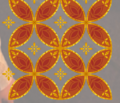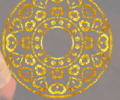Taiwan floral fabric
Taiwanese floral fabric, also known as printed fabric (印花布), bedsheet fabric (被單布), or "huazi" fabric (花仔布), refers to a type of cloth featuring traditional Taiwanese patterns, while blending a rich mix of design elements from Chinese, Japanese, Western, and Taiwanese Indigenous cultures. Taiwanese floral fabric serves a wide variety of purposes and can be used as a decorative pattern for many items, commonly appearing on tablecloths, curtains, bags, wrapping cloths, quilts, or clothing.
Naming
[edit]In Taiwan, the most commonly used name for this fabric is not “Taiwanese floral fabric” but rather “Hakka floral fabric (客家花布).”This type of fabric is deeply cherished by the Taiwanese Hakka community and has become one of the most prominent symbols of Hakka culture.[1][2] However, the term “Hakka floral fabric” can be misleading, as Taiwanese Minnan people, Indigenous peoples, and mainlander communities have all widely used this type of fabric as well. It is not exclusive to the Hakka people. In fact, traditional Hakka textiles are characterized by shades such as cobalt blue, dark indigo, jade green, and midnight blue — quite different from the bright, vivid colors that dominate modern Taiwanese floral fabric today.
History
[edit]Taiwanese floral fabric first appeared during the period of Japanese rule in Taiwan.[3] The Japanese, noticing the island’s abundance of diverse motif, conceived the idea of commercializing these designs. At the same time, the textile industry was in urgent need of labor, which led to the mass production of Taiwanese floral fabric. These fabrics were not only used locally in Taiwan but were also exported extensively to mainland Japan and Manchukuo. The patterns of Taiwanese floral fabric were also influenced by Japanese aesthetics. These fabrics were originally produced by traditional fabric shops, known as “buzhuang (布莊).” After modern industrial cotton fabrics became well-established in Japan, Taiwan’s local fabric shops underwent a complete transformation, switching to cotton as the primary material and incorporating a significant amount of Japanese technology into their production processes.[4]
In 1946, following Japan’s surrender to the United States, which marked the end of World War II, the Republic of China took over Taiwan. Between the 1950s and 1960s, with the rapid development of Taiwan’s textile industry, Taiwanese floral fabric was mass-produced. Due to the Republic of China’s “Sinicization(中國化)” policy, the patterns of Taiwanese floral fabric gradually shifted to emphasize Chinese styles, particularly those influenced by the Qing Dynasty and the aesthetics of the Republic of China, while other pattern styles saw a significant decline.[5] The version of Taiwanese floral fabric we are most familiar with today typically features bright vermilion red or light blue backgrounds, adorned with large, blooming motifs such as peonies, chinese dragons, fenghuangs, lotuses, and “Eight Treasures” patterns. The most iconic styles of Taiwanese floral fabric were born during this era.
After the 1970s, due to its high production volume, low price, and gaudy patterns, Taiwanese floral fabric gradually came to be regarded as a “cheap product.” Some people in Taiwan also criticized it for being overly traditional and outdated, leading to a significant decline in its production. During the 1980s and 1990s, with the lifting of martial law and the democratization of Taiwan, many local designers and artists began to view Taiwanese floral fabric as a creative medium and started using it as a source of inspiration for reinterpretations and innovative designs.
From the 2000s to the 2010s, the Taiwanese Hakka community actively revived the cultural significance of Taiwanese floral fabric within Hakka history and promoted it extensively. After the 2020s, with the rise of the “Taiwanization” and the “hipster design aesthetic[6],” Taiwanese floral fabric began to incorporate more Western, Japanese, and Indigenous patterns, while also drawing inspiration from Ming and Tang dynasty motifs preserved in the National Palace Museum in Taipei. This shift emphasized more elegant and luxurious color schemes, aiming to move away from the previously perceived gaudiness. Today, the patterns of Taiwanese floral fabric are rich and diverse enough to create hundreds of possible combinations, all imbued with a distinctly Taiwanese character.[7]
Examples of Taiwanese Floral Fabric Patterns
[edit]-
Peony Pattern from the Qing Dynasty Era (The Most Frequently Appearing Motif in Hakka Printed Fabric)
-
Chinese Dragon, Phoenix, and Lotus Pattern from the Qing Dynasty Era
-
Chinese Dragon, Phoenix, and Flower Pot Pattern from the Qing Dynasty Era
-
Double Phoenix and Lotus Pattern from the Ming Dynasty Era
-
Baoxiang Flower and Grape Pattern from the National Palace Museum, Taipei
-
Baoxiang Flower and Eight Treasures Pattern from the National Palace Museum, Taipei
-
Blackish-Blue Six-Petal Lotus Pattern from the National Palace Museum, Taipei
-
Plum Blossom and Six-Petal Lotus Pattern from the Republic of China Era
-
Snowflake Wheel Pattern in Tang Dynasty–Japanese Fusion Style
-
Double Birds Singing Pattern in Gongbi Painting Style
-
Birds and Branches Pattern in Gongbi Painting Style
-
Butterfly Medallion Pattern in Gongbi Painting Style
-
Hakka Style Square Peony Pattern
-
Indigenous Style Pattern 1 (Tribal Motif)
-
Indigenous Style Pattern 2 (Imitation Tang Ruby Pattern)
-
Indigenous Style Pattern 3 (Imitation Japanese Snowflake Wheel Pattern)
-
Indigenous Style Pattern 4 (Imitation Japanese Square Diamond Pattern)
-
Beam and Pillar Painted Pattern from the Ming Dynasty Era
-
Imitation Tang Bundled Lotus Petal Pattern
-
Luxurious Pattern in Taiwanese Indigenous Style
-
Hakka Copper Coin Pattern (Crossed Arrangement)
-
Indigenous and Tang Dynasty Hybrid Pattern 1
-
Indigenous and Tang Dynasty Hybrid Pattern 2
-
Hakka Copper Coin Pattern (Broken Arrangement)
-
Hakka and Indigenous Fusion Style Pattern
-
Hakka Copper Coin Pattern (Western and Japanese Fusion Style)
-
Hakka Copper Coin Pattern (Vertical Arrangement)
-
Taiwanese Vintage Toy Pattern (Flat Square Diamond, Tang Dynasty–Japanese Fusion Style 1)
-
Taiwanese Vintage Toy Pattern (Flat Square Diamond, Tang Dynasty–Japanese Fusion Style 2)
References
[edit]- ^ 客家委員會全球資訊網. "客家花布的符號消費與族群認同". www.hakka.gov.tw (in Chinese (Taiwan)). Archived from the original on 2023-05-01. Retrieved 2023-05-01.
- ^ "客家花布產業發展之研究:以資源基礎的觀點". 臺灣博碩士論文知識加值系統. Archived from the original on 2023-05-03. Retrieved 2023-05-01.
- ^ "別再叫我客家花布-台灣花布歷史3分鐘搞懂!". www.laihao.com.tw (in Traditional Chinese). Archived from the original on 2023-05-06. Retrieved 2023-11-01.
- ^ "花布時代─漫談臺灣花布的圖騰與美學". www.sshcf.org.tw. Retrieved 2023-05-01 – via 上善人文基金會.
- ^ "中華傳統民俗技藝團-客家花布". www.mfa.org.tw. Archived from the original on 2023-11-01. Retrieved 2023-11-01.
- ^ "史上最多台灣傳統花布708款式蒐羅、最有系統的紋樣分類、最具脈絡的文化解讀!《花樣時代:台灣花布美學新視界》". www.books.com.tw. Archived from the original on 2023-05-04. Retrieved 2023-05-01.
- ^ "傳統與前衛交鋒,花布盛世,驚豔重現!《花樣時代》台灣花布美學新視界". www.ylib.com. Archived from the original on 2023-11-01. Retrieved 2023-11-01.
- 陳宗萍. 花樣時代:台灣花布美學新視界. 臺灣: 遠流出版社. ISBN 9789573270645.
- 吳清桂. 台灣花布:收藏台灣最美麗的情感與記憶. 臺灣: 大塊文化出版股份有限公司. ISBN 9789862131718.

























